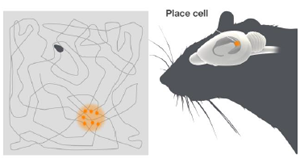
By recording single-cell activity while rats explored
an open field, Dr. John O’Keefe identified “Place Cells”
located in the hippocampus. Place cells only fire when an
animal enters a specific location in a given environment,
and the activity of these cells allows animals to form a
cognitive map of their surroundings.
Credit: "The 2014 Nobel Prize in Physiology or Medicine -
Advanced Information ".Nobelprize.org. Nobel Media
AB 2014. Web. 10 Oct 2014.
NINDS congratulates the 2014 Nobel Prize winners in Physiology or Medicine, neuroscientists John M. O’Keefe, Ph.D. (University College London), May-Britt Moser, Ph.D., and Edvard I. Moser, Ph.D. (Norwegian University of Science and Technology), who received the award “for their discoveries of cells that constitute a positioning system in the brain.” This research illustrates how asking questions about basic neuroscience principles can dramatically influence our understanding of brain circuitry and behavior, and provides insight into disorders of the nervous system.
Advancing the 1948 report (PDF, 1MB) by Edward Tolman, Ph.D., who proposed that rats form mental maps to navigate through mazes, Dr. O’Keefe used the best single-cell recording techniques available in the 1960’s and ‘70’s to identify specific “place cells,” which encode information in the brain about the environment. By measuring the activity of single neurons in discrete regions of the hippocampus while a rodent explored a bounded environment, O’Keefe first showed that these cells change their activity depending on a subject’s particular position in an environment. O’Keefe eventually demonstrated that the firing patterns of place cells create an internal map of the surrounding environment.
In the early 2000’s, Drs. Moser discovered that the entorhinal cortex, an adjacent region connected to the hippocampus, contained “grid cells” which activate in a hexagonal grid pattern as subjects encounter multiple locations in an environment. The researchers disconnected networks between the entorhinal cortex and hippocampus and, through electrophysiological recordings, confirmed that “place cells” isolated in each region continued to track environment. Yet the Mosers took these investigations one step further by recording from multiple cells simultaneously in rodents who had a much larger environment to navigate. Through these experiments, Moser and Moser revealed that the grid cells function in a network alongside cells that respond to head movement and the borders of a given environment. The never-before measured activity of grid cells in this network provides a method for animals to track and measure distance traveled internally for future reference.
Additional theoretical, mapping, and pre-clinical lesion experiments by O’Keefe, the Mosers, and others confirmed reciprocal connections between place and grid cells that form a cognitive navigational system in rodents. More recently, with the advancement of neurotechnologies like implantable devices and fMRI, these basic discoveries were increasingly applied to human patients to illustrate conservation of the grid-place cell system across species.
This application of basic research knowledge has opened new doors to our understanding of memory and spatial orientation. For example, neurodegenerative disorders like Alzheimer’s disease cause trouble with spatial memory, due to damage that occurs in the hippocampus and entorhinal cortex. Here at NINDS, we champion neuroscience research that spans basic, translational, and clinical realms – just like this – to achieve our mission of broadening fundamental knowledge of the brain to reduce the burden of neurological disease. Indeed, the BRAIN Initiative represents a new, program to help scientists develop, test, and apply the latest neurotechnologies to enable future Nobel Laureates to make fundamental discoveries in neuroscience.
